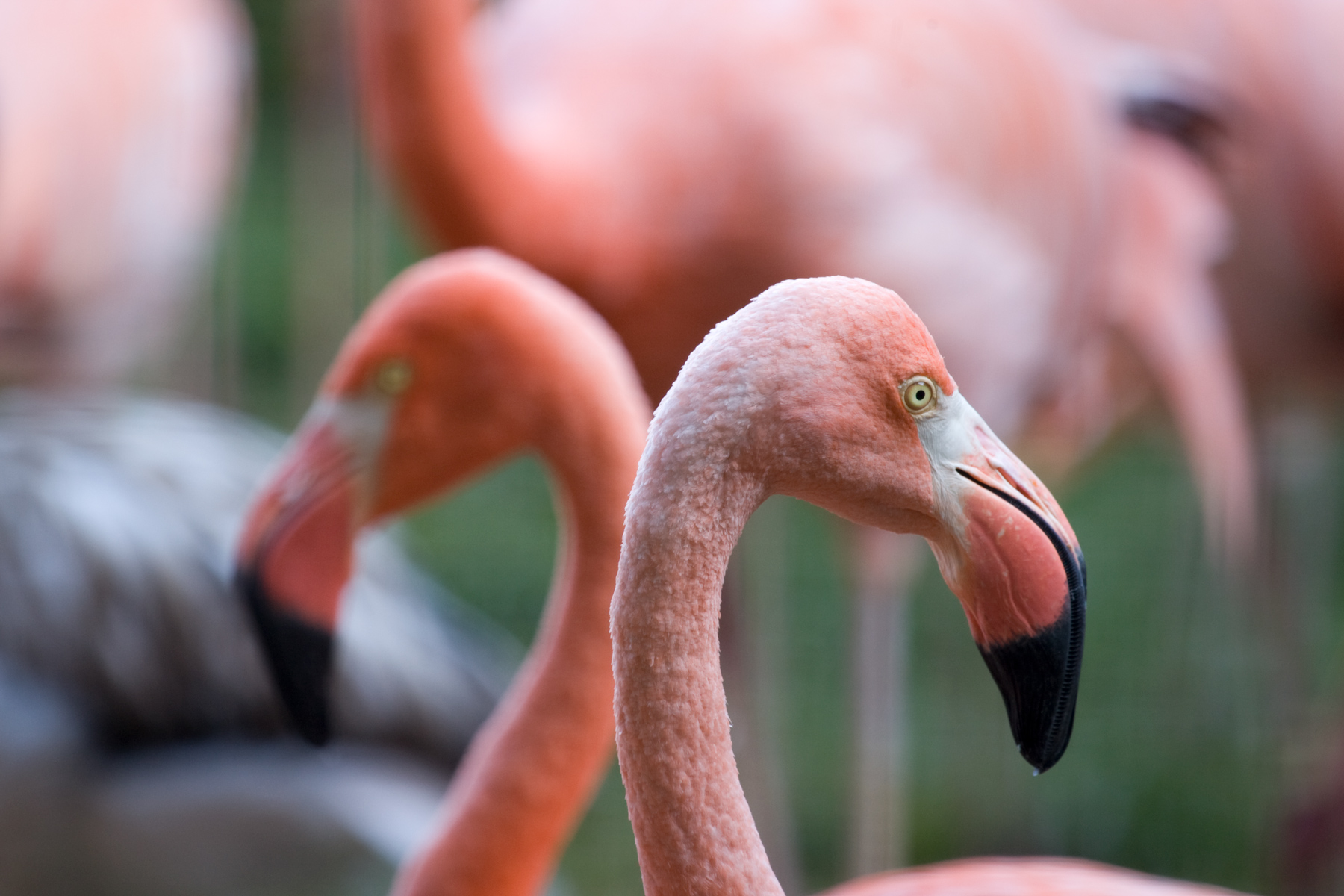Flamingos are captivating, pink birds known for their striking color and unique behavior. These birds thrive in salty lakes and lagoons.
Flamingos, with their vibrant pink plumage, are a true marvel of nature. Their distinct color comes from their diet, rich in beta-carotene found in algae and crustaceans. These social birds often gather in large colonies, creating stunning spectacles in their habitats.
Flamingos are wading birds, using their long legs to navigate shallow waters in search of food. Their unique feeding technique, involving upside-down beak filtering, sets them apart from other birds. Observing flamingos in their natural environment offers a glimpse into the fascinating adaptations that make these creatures so extraordinary. Dive into the world of flamingos and discover what makes them truly special.
The Allure Of Flamingos
Flamingos captivate our imagination with their vibrant colors and elegant stance. These birds are known for their stunning pink feathers and graceful movements. Flamingos charm us with their social behavior and unique lifestyle.
Iconic Pink Plumage
The pink plumage of flamingos is their most defining feature. This color comes from the pigments in their diet. Flamingos eat algae, shrimp, and other crustaceans rich in carotenoids. These pigments turn their feathers pink and orange.
The intensity of their color depends on their diet. A well-fed flamingo will have brighter feathers. Younger flamingos have gray feathers that turn pink as they mature.
Cultural Symbolism
Flamingos hold a special place in various cultures. They are often seen as symbols of beauty, grace, and elegance. In ancient Egypt, flamingos were associated with the sun god Ra. They were considered sacred and respected.
In modern times, flamingos represent fun and relaxation. They are popular in art, fashion, and garden decorations. People use flamingo motifs for parties and events to create a tropical vibe.
Here is a table that highlights some interesting facts about flamingos:
| Fact | Details |
|---|---|
| Scientific Name | Phoenicopterus |
| Average Lifespan | 20-30 years |
| Habitat | Lakes, lagoons, and estuaries |
| Diet | Algae, shrimp, and small insects |
Flamingos are truly fascinating birds. Their pink plumage and cultural significance make them stand out. Whether in the wild or in art, flamingos continue to enchant us.

Credit: nationalzoo.si.edu
Flamingo Biology 101
Flamingos are among the most fascinating birds on Earth. Their pink feathers and unique behaviors make them a subject of interest. In this section, we dive into the biology of these amazing birds.
Unique Anatomy
Flamingos possess some truly unique anatomical features:
- Long Legs: Their long legs help them wade through deep waters.
- Webbed Feet: These feet allow them to walk on soft mud without sinking.
- Curved Beak: Their beak is specially designed to filter food from water.
- Pink Feathers: The pink color comes from their diet, rich in carotenoids.
Adaptive Behaviors
Flamingos have developed several adaptive behaviors to thrive in their environments:
- Filter Feeding: They use their beaks to filter out small organisms from the water.
- Social Living: Flamingos live in large colonies, which helps protect them from predators.
- One-Legged Stance: They often stand on one leg to conserve body heat.
- Mud Nests: Flamingos build nests out of mud to keep their eggs safe and dry.
| Unique Feature | Purpose |
|---|---|
| Long Legs | Wading through deep waters |
| Webbed Feet | Walking on soft mud |
| Curved Beak | Filtering food from water |
| Pink Feathers | Result of a carotenoid-rich diet |
Diet And The Pink Hue
The vibrant pink color of flamingos is truly mesmerizing. This unique hue isn’t just for show. It has a lot to do with what they eat. Let’s dive deeper into their diet and how it affects their color.
Role Of Carotenoids
Flamingos get their pink color from carotenoids found in their food. Carotenoids are pigments in algae and crustaceans. These pigments are absorbed by flamingos and then transformed into their pink feathers.
Carotenoids act as antioxidants and boost the bird’s immune system. Without these, flamingos would not be pink. They would be a dull gray or white.
Feeding Habits
Flamingos have unique feeding habits that help them get carotenoids. They use their beaks to filter-feed in water. Their diet includes:
- Algae
- Small crustaceans
- Plankton
Flamingos often feed in shallow lakes, lagoons, and mangrove swamps. They stir up the mud and capture their food with their specialized beaks.
They may feed during the day or night, depending on food availability. Their feeding techniques ensure a steady supply of carotenoids.
| Food Source | Carotenoid Content |
|---|---|
| Algae | High |
| Crustaceans | Medium |
| Plankton | Low |
This table shows the different food sources and their carotenoid content. Flamingos prefer algae due to its high carotenoid content.

Credit: rangerrick.org
Habitats Around The Globe
Flamingos are amazing creatures with their bright pink feathers. They live in various habitats around the world. Let’s explore their preferred environments and geographical distribution.
Preferred Environments
Flamingos love water. They thrive in lakes, lagoons, and swamps. These birds also enjoy salty and alkaline waters.
They often choose areas with mudflats or sandbanks. These places help them find food easily. Flamingos eat algae, crustaceans, and small fish.
Flamingos are social birds. They prefer living in large flocks. This behavior protects them from predators and helps them find more food.
Geographical Distribution
Flamingos can be found on every continent except Antarctica. Each species has its own specific range.
| Flamingo Species | Geographical Range |
|---|---|
| Greater Flamingo | Africa, Southern Europe, South Asia |
| Lesser Flamingo | Africa, Northwestern India |
| Chilean Flamingo | South America |
| Andean Flamingo | Andes Mountains in South America |
| James’s Flamingo | High Andes in Peru, Chile, Bolivia, and Argentina |
| American Flamingo | Caribbean, Galapagos Islands, Northern South America |
Each species adapts to its unique habitat. Greater Flamingos live in warm regions. Andean Flamingos live in high, cold areas.
Flamingos migrate to find food and breeding grounds. These migrations are crucial for their survival.
Mating Rituals And Reproduction
Flamingos are known for their striking pink feathers and elegant stance. But their mating rituals and reproduction methods are equally fascinating. These social birds engage in elaborate courtship displays and share parenting duties. Let’s explore the intriguing world of flamingo mating and reproduction.
Courtship Displays
Flamingos perform synchronized displays to attract mates. These displays include head-flagging, wing-saluting, and twist-preening. During head-flagging, flamingos stretch their necks and move their heads side to side. Wing-saluting involves spreading their wings to show off colorful feathers. In twist-preening, flamingos twist their bodies and preen their feathers. These synchronized movements help form pairs within the flock.
Nesting And Parenting
Once paired, flamingos build nests out of mud. They create mounds about one foot high to keep eggs safe from flooding. Both parents take turns incubating the egg. Flamingos lay one egg per season. The incubation period lasts around 30 days.
After hatching, flamingo chicks are covered in gray or white down feathers. Both parents feed the chick with a special milk called crop milk. This milk is rich in nutrients and helps the chick grow quickly. Flamingo chicks join a group called a crèche. In the crèche, they learn important survival skills from other chicks and adult flamingos.
| Stage | Duration | Key Activities |
|---|---|---|
| Courtship | Several weeks | Displays like head-flagging and wing-saluting |
| Nesting | 30 days | Building mud mounds, incubating eggs |
| Parenting | Several months | Feeding chicks with crop milk, protecting them |
Social Flocks And Communication
Flamingos are known for their vibrant pink feathers. These stunning birds are also fascinating in their social behaviors and communication styles. Let’s dive into the world of flamingo flocks and how they talk to each other.
Flock Dynamics
Flamingos live in large flocks called colonies. These colonies can have thousands of birds. Living in such big groups has many benefits.
- Protection: More eyes to spot predators.
- Feeding: Easier to find food sources.
- Breeding: Better chances of finding a mate.
Flock dynamics are complex. Each bird has a role. Some lead, others follow. This structure helps maintain order in the colony.
Vocalizations And Signals
Flamingos use various sounds and signals to communicate. Their calls can be loud and distinctive.
Below is a table of common flamingo vocalizations and their meanings:
| Vocalization | Meaning |
|---|---|
| Honk | Alert others of danger |
| Grunt | Show contentment |
| Chirp | Communicate with chicks |
Flamingos also use body language. They stretch their necks to show dominance. They dip their heads to indicate submission.
These signals help maintain harmony in the flock. Understanding these behaviors can give us a deeper appreciation for these pink birds.
Conservation Efforts
Flamingos are beautiful pink birds. They need our help to survive. Many people work hard to protect them. Let’s learn about the threats they face and the measures to save them.
Threats To Flamingo Populations
Flamingos face many threats in the wild. Some of these threats include:
- Habitat Loss: Wetlands dry up due to human activities.
- Pollution: Chemicals and trash harm their homes.
- Climate Change: Weather changes affect their food and water.
- Illegal Hunting: People hunt flamingos for their feathers.
Protective Measures
People are taking steps to help flamingos. Here are some protective measures:
- Creating Protected Areas: Special places where flamingos can live safely.
- Cleaning Wetlands: Removing trash and chemicals from their homes.
- Monitoring Populations: Keeping track of flamingo numbers and health.
- Educating Communities: Teaching people how to protect flamingos.
Here is a table showing some important protective measures:
| Protective Measure | Description |
|---|---|
| Creating Protected Areas | Special places where flamingos can live safely. |
| Cleaning Wetlands | Removing trash and chemicals from their homes. |
| Monitoring Populations | Keeping track of flamingo numbers and health. |
| Educating Communities | Teaching people how to protect flamingos. |

Credit: www.amazon.com
Flamingos In Culture And Art
Flamingos, with their striking pink feathers and graceful stance, have always fascinated humans. These birds have not only captured the attention of bird watchers but have also found a significant place in various cultures and art forms throughout history. Their unique beauty and elegance have inspired many artists and cultural traditions.
Historical Significance
Flamingos have appeared in ancient art and symbolism. In ancient Egypt, flamingos were considered sacred birds. They were often depicted in hieroglyphs and tomb paintings. The Egyptians believed flamingos were the living representation of the sun god, Ra.
In Greek mythology, flamingos were associated with the god Apollo. They were symbols of beauty and balance. These birds also appeared in Roman mosaics and frescoes, showcasing their importance in ancient times.
Modern Day Inspirations
In modern times, flamingos have continued to inspire various forms of art and culture. Their image is popular in contemporary art, fashion, and design. Flamingos are often featured in pop culture, from movies to home decor.
Flamingos have also become symbols of tropical and exotic beauty. They are frequently seen in advertisements and branding for summer products. Their vibrant pink color and elegant pose make them ideal subjects for visual arts.
Additionally, flamingos have become popular motifs in festivals and celebrations. They are often used in decorations for events like weddings and parties, adding a touch of exotic charm.
Frequently Asked Questions
Why Are Flamingos Pink?
Flamingos are pink due to their diet. They consume algae and crustaceans rich in carotenoids. These pigments turn their feathers pink.
How Long Do Flamingos Live?
Flamingos can live up to 30 years in the wild. In captivity, their lifespan can extend to 50 years.
What Do Flamingos Eat?
Flamingos eat algae, small insects, and crustaceans. Their diet is rich in carotenoids, giving them their pink color.
Where Do Flamingos Live?
Flamingos are found in warm, watery regions. They inhabit lakes, lagoons, and mangrove swamps across Africa, Asia, America, and Europe.
Conclusion
Flamingos captivate us with their vibrant colors and unique behaviors. These birds thrive in diverse habitats worldwide. Understanding flamingos enhances our appreciation for nature’s wonders. Protecting their environments ensures future generations can enjoy these magnificent creatures. Explore more about flamingos to deepen your knowledge and passion for wildlife conservation.











